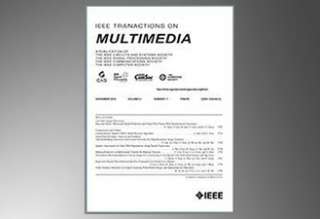SPS Feed
Top Reasons to Join SPS Today!
1. IEEE Signal Processing Magazine
2. Signal Processing Digital Library*
3. Inside Signal Processing Newsletter
4. SPS Resource Center
5. Career advancement & recognition
6. Discounts on conferences and publications
7. Professional networking
8. Communities for students, young professionals, and women
9. Volunteer opportunities
10. Coming soon! PDH/CEU credits
Click here to learn more.
The Latest News, Articles, and Events in Signal Processing
Date: 18-20 June 2024
Location: Karlshamn, Sweden
Date: 15-16 July 2024
Location: Niagara Falls, Canada
The modeling of time-varying graph signals as stationary time-vertex stochastic processes permits the inference of missing signal values by efficiently employing the correlation patterns of the process across different graph nodes and time instants. In this study, we propose an algorithm for computing graph autoregressive moving average (graph ARMA) processes based on learning the joint time-vertex power spectral density of the process from its incomplete realizations for the task of signal interpolation.
Conventional beamforming methods for intelligent reflecting surfaces (IRSs) or reconfigurable intelligent surfaces (RISs) typically entail the full channel state information (CSI). However, the computational cost of channel acquisition soars exponentially with the number of IRSs. To bypass this difficulty, we propose a novel strategy called blind beamforming that coordinates multiple IRSs by means of statistics without knowing CSI.
Algorithmic solutions for multi-object tracking (MOT) are a key enabler for applications in autonomous navigation and applied ocean sciences. State-of-the-art MOT methods fully rely on a statistical model and typically use preprocessed sensor data as measurements. In particular, measurements are produced by a detector that extracts potential object locations from the raw sensor data collected at discrete time steps. This preparatory processing step reduces data flow and computational complexity but may result in a loss of information.
This paper proposes an interpretable ensembled seizure detection procedure using electroencephalography (EEG) data, which integrates data driven features and clinical knowledge while being robust against artifacts interference.
This work explores the challenging problems of nonlinear dynamics, nonaffine structures, heterogeneous properties, and deception attack together and proposes a novel distributed model-free adaptive predictive control (DMFAPC) for multiple-input-multiple-output (MIMO) multi-agent systems (MASs). A dynamic linearization method is introduced to address the nonlinear heterogeneous dynamics which is transformed as the unknown parameters in the obtained linear data model.
Representation learning considering high-order relationships in data has recently shown to be advantageous in many applications. The construction of a meaningful hypergraph plays a crucial role in the success of hypergraph-based representation learning methods, which is particularly useful in hypergraph neural networks and hypergraph signal processing.
The Random Dot Product Graph (RDPG) is a generative model for relational data, where nodes are represented via latent vectors in low-dimensional Euclidean space. RDPGs crucially postulate that edge formation probabilities are given by the dot product of the corresponding latent positions. Accordingly, the embedding task of estimating these vectors from an observed graph is typically posed as a low-rank matrix factorization problem.
Instance-level human parsing is aimed at separately partitioning the human body into different semantic parts for each individual, which remains a challenging task due to human appearance/pose variation, occlusion and complex backgrounds. Most state-of-the-art methods follow the “parsing-by-detection” paradigm, which relies on a trained detector to localize persons and then sequentially performs single-person parsing for each person. However, this paradigm is closely related to the detector, and the runtime is proportional to the number of persons in an image.
Pedestrian attribute recognition (PAR) aims to generate a structured description of pedestrians and plays an important role in surveillance. Current work focusing on 2D images can achieve decent performance when there is no variation in the captured pedestrian orientation. However, the performance of these works cannot be maintained in scenarios when the orientation of pedestrians is ignored.
Zero-shot learning (ZSL) has received extensive attention recently especially in areas of fine-grained object recognition, retrieval, and image captioning. Due to the complete lack of training samples and high requirement of defense transferability, the ZSL model learned is particularly vulnerable against adversarial attacks. Recent work also showed adversarially robust generalization requires more data.
Domain generalization aims to reduce the vulnerability of deep neural networks in the out-of-domain distribution scenario. With the recent and increasing data privacy concerns, federated domain generalization, where multiple domains are distributed on different local clients, has become an important research problem and brings new challenges for learning domain-invariant information from separated domains.
As compared to standard dynamic range (SDR) videos, high dynamic range (HDR) content is able to represent and display much wider and more accurate ranges of brightness and color, leading to more engaging and enjoyable visual experiences. HDR also implies increases in data volume, further challenging existing limits on bandwidth consumption and on the quality of delivered content.
Remote Photoplethysmography (rPPG) has been attracting increasing attention due to its potential in a wide range of application scenarios such as physical training, clinical monitoring, and face anti-spoofing. On top of conventional solutions, deep-learning approach starts to dominate in rPPG estimation and achieves top-level performance.
Cross-component prediction is an important intra-prediction tool in the modern video coders. Existing prediction methods to exploit cross-component correlation include cross-component linear model and its extension of multi-model linear model. These models are designed for camera captured content. For screen content coding, where videos exhibit different signal characteristics, a cross-component prediction model tailored to their characteristics is desirable.
Graph Convolutional Networks (GCN) which typically follows a neural message passing framework to model dependencies among skeletal joints has achieved high success in skeleton-based human motion prediction task. Nevertheless, how to construct a graph from a skeleton sequence and how to perform message passing on the graph are still open problems, which severely affect the performance of GCN.
We provide an expressive framework that allows analyzing and generating provably secure, state-of-the-art Byzantine fault-tolerant (BFT) protocols over graph of nodes, a notion formalized in the HotStuff protocol. Our framework is hierarchical, including three layers. The top layer is used to model the message pattern and abstract core functions on which BFT algorithms can be built.
Website Fingerprinting (WF) is a network traffic mining technique for anonymous traffic identification, which enables a local adversary to identify the target website that an anonymous network user is browsing. WF attacks based on deep convolutional neural networks (CNN) get the state-of-the-art anonymous traffic classification performance. However, due to the locality restriction of CNN architecture for feature extraction on sequence data, these methods ignore the temporal feature extraction in the anonymous traffic analysis.
Pages
SPS on Twitter
- DEADLINE EXTENDED: The 2023 IEEE International Workshop on Machine Learning for Signal Processing is now accepting… https://t.co/NLH2u19a3y
- ONE MONTH OUT! We are celebrating the inaugural SPS Day on 2 June, honoring the date the Society was established in… https://t.co/V6Z3wKGK1O
- The new SPS Scholarship Program welcomes applications from students interested in pursuing signal processing educat… https://t.co/0aYPMDSWDj
- CALL FOR PAPERS: The IEEE Journal of Selected Topics in Signal Processing is now seeking submissions for a Special… https://t.co/NPCGrSjQbh
- Test your knowledge of signal processing history with our April trivia! Our 75th anniversary celebration continues:… https://t.co/4xal7voFER









